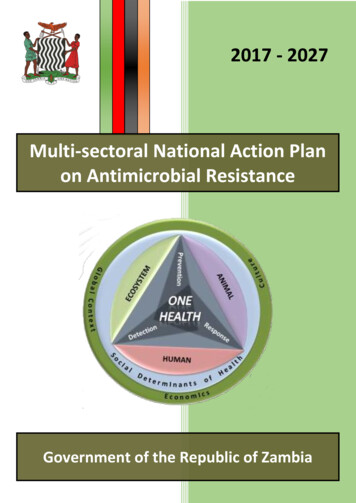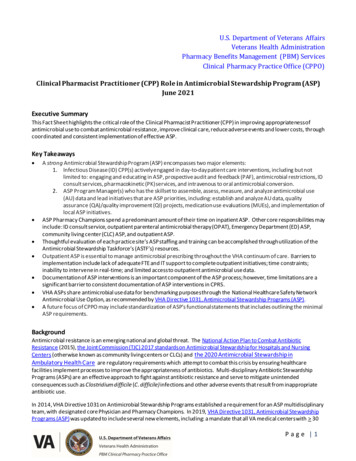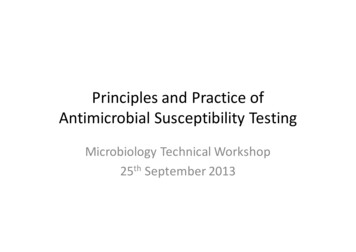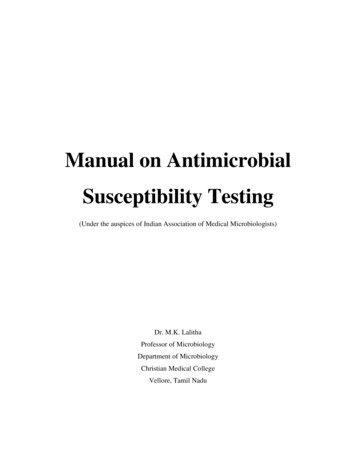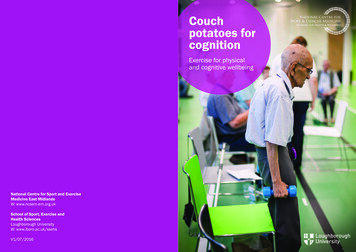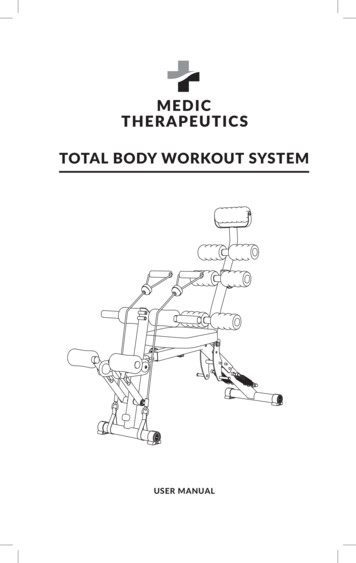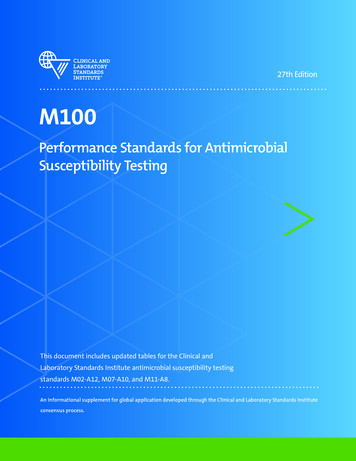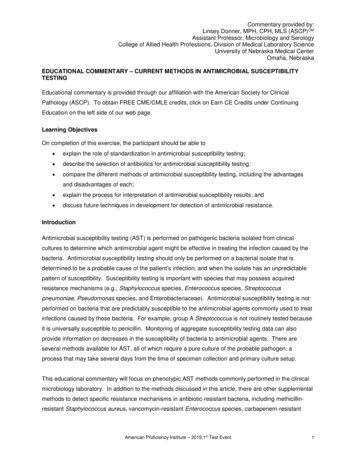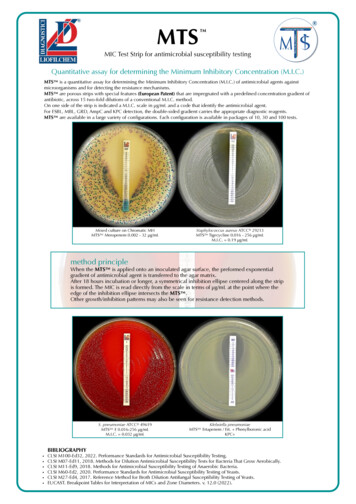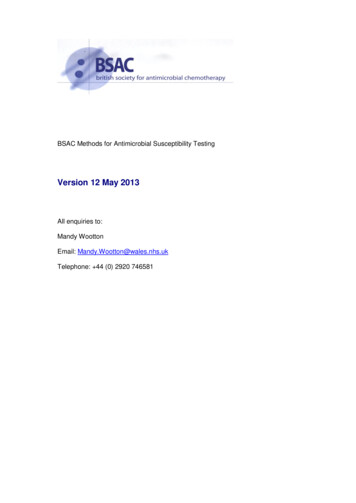
Transcription
Tackling antimicrobial resistance2019–2024The UK’s five-year national action planPublished 24 January 2019
Tackling antimicrobial resistance 2019–2024ContentsForeword. 3Abbreviations . 5Executive summary . 71. Introduction . 91.1. Existing efforts . 122. Reducing need for and unintentional exposure to antimicrobials . 272.1. Lower burden of human infection . 272.2. Greater global access to clean water and sanitation . 362.3. Lower burden of animal infection . 382.4. Minimise spread of AMR through the environment . 442.5. Better food safety . 493. Optimising use of antimicrobials . 533.1. Optimal use of antimicrobials in humans . 533.2. Optimal use of antimicrobials in animals and agriculture . 603.3. Stronger laboratory capacity and surveillance of AMR in humans . 653.4. Stronger laboratory capacity and surveillance of AMR in animals . 694. Investing in innovation, supply and access to tackle AMR . 714.1. Sustainable investment in basic research. 714.2. Development of new therapeutics . 744.3. Wider access to therapeutics for those who need them . 774.4. Development of, and access to, diagnostics . 804.5 Development of, and access to, vaccines. 844.6. Better quality assurance of AMR health products . 88Glossary of terms . 912
Tackling antimicrobial resistance 2019–2024ForewordAntimicrobials, particularly antibiotics, have saved millions of lives since they were firstdiscovered. Our generation, and that of our parents, has benefited enormously from theseimportant medicines.But no new classes of antibiotic have been discovered since the 1980s. This, together withthe increased and inappropriate use of the drugs we already have, means we are headingrapidly towards a world in which our antibiotics no longer work. We need to act, and actnow, to make sure that our children and future generations continue to benefit from theselife-saving medicines.We are proud of the work that the UK has done to secure antimicrobial resistance (AMR)on the global agenda, not just as a health issue, but as a ‘One-Health’ issue withenormous social and economic impact. We have worked hard with the World HealthOrganization, the World Organisation for Animal Health and the Food and AgricultureOrganization to secure commitment to a global action plan in 2014 and the historic politicaldeclaration on AMR at the United Nations in 2016. We have invested to turn declarationsinto concrete action and to support countries to develop their capacity to tackle AMR, toimprove global surveillance and to do the research and development work that we needthrough international collaborations.In the UK, we have human and animal surveillance systems and levels of researchcoordination and collaboration that are respected by many of our global partners and wewant to share our good work and innovative approaches while continuing to learn from thebest.Our vision for AMR in 2040 recognises that a global problem as significant and complex asantimicrobial resistance will not be addressed in a single five-year plan. The nationalaction plan, published alongside the vision, aims to build on our achievements so far. It isessential that we continue to make progress and through this plan, we are pushingourselves harder with a new set of challenging ambitions for the next five years.Preventing infections is essential and our new plan has a strong focus on infectionprevention and control. We are the first country to set an ambition to reduce the actualnumber of resistant infections. We aim to develop real time patient level data so thatclinicians can see infection, treatment and resistance histories to optimise life-savingtreatments for serious infections, including sepsis, and to help develop new interventionsfor AMR. We will build on our already considerable achievements in reducing antibiotic usein animals by working to improve animal health and address endemic disease issues, andwe will improve our understanding of the routes of transmission of resistance including theimpact of the environment and food.3
Tackling antimicrobial resistance 2019–2024We are leading the way in testing solutions that will address our global failure to incentivisethe development of new antimicrobials and alternative treatments. We will test a newmodel that will de-link the payments made to companies from the volumes of antibioticssold, basing the payment on a NICE led assessment of the value of the medicines andsupporting good stewardship.The plan is structured using the United Nation’s Ad-hoc Interagency Framework for Actionon AMR and sets out the need for action in 15 areas, together with what we are doingdomestically and how we are supporting global action in each area. We will work withother countries to help build this as a blue print for their own plans.Our 20-year vision and five-year plan have been developed collaboratively across diversegovernment agencies, working with governments in Scotland and Wales, theadministration in Northern Ireland, our national health services and animal health andwelfare agencies. Together, we have set out a fully integrated and aligned UK One-Healthapproach.Through this plan we are setting out our challenge to ourselves and to other countries tocontinue our excellent work together to preserve and develop these essential medicinesfor generations to come and help us address one of the most pressing global healthchallenges we face this century.4
Tackling antimicrobial resistance ANAPNHSNICENIHROIEAcademic Health Science NetworkAntimicrobial resistanceAssessment Tool for Laboratory and Antimicrobial ResistanceAccess, Watch and ReserveBritish Small Animal Veterinary AssociationBritish Veterinary AssociationBovine Viral DiarrhoeaClinical Commissioning GroupCarbapenemase producing organismDepartment for Environment, Food and rural AffairsDepartment of Health and Social CareEuropean CommunityEuropean UnionEnzoonotic PneumoniaFood and Agriculture OrganisationFoundation for Innovative New DiagnosticsFood Standards AgencyFood Standards ScotlandGlobal Antimicrobial Resistance Innovation FundThe Global Vaccine AllianceGlobal Action PlanGlobal Antibiotic Research and Development PartnershipGlobal Antimicrobial Resistance Surveillance SystemThe Group of 7 (Canada, France, Germany, Italy, Japan, the United Kingdom,and the United States.)The Group of 20Healthcare Associated InfectionInteragency Coordination GroupInternational Health RegulationIntestinal Infectious DiseaseInfection prevention and controlJoint Programming Initiative on Antimicrobial ResistanceLow- and middle-income countriesmilligram per kilogramMedicines and Healthcare Products Regulatory AgencyNational Action PlanNational Health ServiceNational Institute for Health and Care ExcellenceNational Institute for Health ResearchWorld Organisation for Animal Health5
Tackling antimicrobial resistance STEMTARGETTBUKUKRIUNUNICEFUTIVMDWASHWHOProduct Development PartnershipPeople’s Dispensary for Sick AnimalsPublic Health EnglandPrescription Only MedicinePatient Safety CollaborativePorcine Reproductive and Respiratory SyndromeResearch and DevelopmentRoyal College of General PractitionersSustainable Development GoalsSmall and Medium EnterprisesAMR Supporting the National Action Plan for AMR in TanzaniaScience Technology Engineering and MathematicsTreat Antibiotics Responsible, Guidance, Education and ToolsTuberculosisUnited KingdomUnited Kingdom Research and InnovationUnited NationsUnited Nations Children’s FundUrinary Tract InfectionVeterinary Medicines DirectorateWater Sanitation and HygieneWorld Health Organisation6
Tackling antimicrobial resistance 2019–2024Executive summaryAntimicrobial resistance (AMR) is a global problem that impacts all countries and allpeople, regardless of their wealth or status. The scale of the AMR threat, and the need tocontain and control it, is widely acknowledged by country governments, internationalagencies, researchers and private companies alike.This document sets out the UK’s 2019–2024 national action plan to tackle AMR within andbeyond our own borders. Developed in consultation with a broad range of stakeholdersacross different sectors, it builds on the achievements of our last strategy (2013–2018),and is aligned with global plans and frameworks for action.The plan has ultimately been designed to ensure progress towards our 20-year vision onAMR, in which resistance is effectively contained and controlled. It focuses on three keyways of tackling AMR: reducing need for, and unintentional exposure to, antimicrobials; optimising use of antimicrobials; and investing in innovation, supply and access.These are underpinned by actions across 15 ‘content areas’, ranging from reducinginfection and strengthening stewardship to improving surveillance and boosting research.The plan also sets out four measures of success to ensure progress towards our 20-yearvision. These include, among others, targets to: halve healthcare associated Gram-negative blood stream infections; reduce the number of specific drug-resistant infections in people by 10% by 2025; reduce UK antimicrobial use in humans by 15% by 2024; reduce UK antibiotic use in food-producing animals by 25% between 2016 and2020 and define new objectives by 2021 for 2025; and be able to report on the percentage of prescriptions supported by a diagnostic testor decision support tool by 2024.Fulfilling our commitments over the next five years requires action across many spheres;we will implement our plan using a risk-based approach, targeting interventions where theevidence for impact is strongest.7
Tackling antimicrobial resistance 2019–2024We rely on the active participation of public and private sector bodies, including investors,across the human health, animal health, the food chain and environment communities.There is too a central role for members of the public, as patients, consumers, animalowners and investors.8
Tackling antimicrobial resistance 2019–20241. IntroductionThe rise and spread of antimicrobial resistance (AMR) is creating anew generation of ‘superbugs’ that cannot be treated with existingmedicines. The impacts of leaving AMR unchecked are wideranging and extremely costly, not only in financial terms but also interms of global health, food sustainability and security,environmental wellbeing, and socio-economic development.Already, AMR infections are estimated to cause 700,000 deaths each year globally. Thatfigure is predicted to rise to 10 million, alongside a cumulative cost of 100 trillion, by 2050if no action is taken. AMR also threatens many of the Sustainable Development Goals(SDGs). The World Bank estimates that an extra 28 million people will be could be forcedinto extreme poverty by 2050 unless AMR is contained.Figure 1. The rise and spread of AMR1In the United Kingdom (UK), rising AMR will cause people to suffer longer infectiousillnesses as they become more difficult to treat, the number of human deaths and sufferingattributable to infectious disease will increase as will the socio-economic costs associatedwith treating ill health in humans.AMR is a global problem that impacts all countries and all people, regardless of theirwealth or status. Resistant organisms respect no borders, neither geographical norecological: the organisms and their resistance genes can easily spread throughmovements of people, animals, food or water; and certain resistance genes can transferfrom one species into another (these genes are called plasmids or transposons). Thismeans that containing and controlling AMR requires coordinated national and internationalaction across all stakeholders, including governments, international organisations, privatebusinesses, investors, civil society, academia and philanthropy.9
Tackling antimicrobial resistance 2019–2024In 2015, Member States of the World Health Organization (WHO), Food and AgricultureOrganization (FAO) and World Organisation for Animal Health (OIE) endorsed a GlobalAction Plan on Antimicrobial Resistance (GAP), which includes five strategic objectivesthat, taken together, offer a framework for national action plans (NAPs) to combat AMRover the following decade.A year later, in 2016, the GAP was reaffirmed as the world’s blueprint for tackling AMRduring the 71st session of the UN General Assembly, where 193 Heads of State adoptedresolution A/RES/71/3, which included a high-level political declaration committingcountries to support and implement the GAP at national, regional and global levels.Since then, the global Ad-hoc Interagency Coordination Group on AMR (IACG)established by the UN Secretary General because of the declaration has developed a‘Framework for Action’ that puts AMR in the wider context of the Sustainable DevelopmentGoals (SDGs), helping to align political agendas and provide a common language and adynamic structure for all sectors to work from, while respecting countries’ endorsement ofthe GAP.The UK was one of the first countries to establish a National Action Plan (NAP) on AMR(even before the GAP), with a strategy and action plan in place as early as 2000. In 2013,we reinforced our NAP approach with a One-Health perspective and published our firstfully integrated five-year strategy for tackling AMR across human and animal health. The2013–2018 AMR strategy committed the UK to action in seven key areas, includinginfection prevention and control, prescribing practice, professional education and public10
Tackling antimicrobial resistance 2019–2024engagement, development of new and innovative treatment and technologies,surveillance, research and international collaboration.This document sets out our next five-year NAP (2019–2024) for tackling AMR. It has beendeveloped in consultation with a broad range of stakeholders across different sectors,including the administrations in Scotland, Wales and Northern Ireland as well as experts,professional bodies, industry and academia. To support a coordinated approach, we usethe IACG Framework for Action to set out our commitments across humans, animals, foodand the environment.Building on the achievements of our 2013–2018 AMR strategy, this UK NAP sets outchallenging ambitions and actions for the next five years that will set us on course forachieving our long-term national and international ambitions, as outlined in our 20-yearvision on AMR.11
Tackling antimicrobial resistance 2019–20241.1. Existing effortsThe UK recognises the need to pursue actions at home and abroad to tackle the globalthreat that is AMR, as highlighted in both our 2013–2018 AMR strategy and theoverarching UK Biological Security Strategy. On both fronts, we undertake a range ofactivities and partnerships, as outlined below (see Figure 2).1.1.1 At a global levelUK action at a global level to tackle AMR is driven by an underlying commitment tointernational collaboration, as made in our 2013–2018 AMR strategy (through the seventhkey area for action). It is underpinned by our belief that effective regulatory, delivery andquality assured systems for humans, animals and the food chain are crucial to preventingand responding to AMR. Strengthening these systems in the UK and overseas will be akey part of what we do over the next five years.Figure 2. UK efforts to tackle AMR include global and domestic activities, identifying drivers of AMR emergence andspreadDriving global advocacy and political agendaEnsuring tangible global progress against the UN’s high-level political declaration and theGAP forms a key pillar of the UK’s international work on AMR. We actively support theIACG in reviewing progress to date and developing recommendations for the future, andwill continue to advocate for bold and ambitious next steps to sustain global momentum.At the same time, we continue to push the AMR agenda forward through our involvementin major international groups and partnerships, including the G7, G20, the Tripartite and12
Tackling antimicrobial resistance 2019–2024UN and inter/multi-lateral organisations, the Alliance of Champions in Geneva and Groupof Friends in New York, to combat AMR and the Global Health Security Agenda. In theanimal health sector, strong UK engagement ensured that a milestone was achieved at the2017 G7 Chief Veterinary Officers’ (CVO) forum where CVOs adopted a position papersetting out a common position on AMR definitions.To strengthen global collaboration, the UK will: help ensure that AMR remains a global priority by continuing to lead international policydialogue at the highest political levels through the G7, G20 and other international andregional fora, and as a major supporter of the UN and wider multilateral system; urge sustained, joined-up international action to address AMR including holding theTripartite Plus (WHO, the FAO OIE and UN Environment (UNEP) and the wider UN familyto account for their individual and collective efforts to address it, and by increasing links tothe delivery of the Sustainable Development Goals. back the development of internationally agreed solutions to promote robust stewardshipand access plans for new and existing antimicrobials and to protect antimicrobials asglobal public goods.Promoting access and responsible useAntimicrobials are crucial medicines in modern healthcare, yet up to two billion people stilllack access to them. Our goal is to optimise antimicrobial use to ensure that more people,especially in low income countries, have access to appropriate medicines when they needthem, including for TB. The UK funds projects overseas to help optimise the use ofantimicrobials through, for example, initiatives to develop NAPs and roll out key protocolsand tools needed to survey AMR and use (see box "The Fleming Fund").We work closely with governments in low- and middle-income countries (LMICs) tostrengthen their health systems, including by improving the quality of care, water andsanitation infrastructure in health facilities and approaches to medicines (see, for example,box 'Supporting Nepal' overleaf).As well as supporting individual countries to promote appropriate use in both human andanimal health, we work with international organisations such as WHO, Gavi, OIE and theGlobal Fund to Fight AIDS, Tuberculosis and Malaria to build reliable supply chains thatcan support effective prevention strategies and ensure quality-assured antimicrobials areavailable where and when they are most needed.13
Tackling antimicrobial resistance 2019–2024Improving detection and surveillanceThrough initiatives like the Fleming Fund, the UK supports LMICs to collect and shareglobally high-quality surveillance data on AMR as well as antimicrobial use and quality forhuman and animal health (see box ‘The Fleming Fund’).We also work to ensure our own AMR surveillance data are consistent and coherent withother countries’ data by participating in WHO’s Global Antimicrobial ResistanceSurveillance System (GLASS), the European Surveillance of Antimicrobial ConsumptionNetwork and the European Antimicrobial Resistance Surveillance Network (EARS-Net) inthe human sector and in the OIE scheme, the European Surveillance of VeterinaryAntimicrobial Consumption and European Food Safety Authority projects in the animalsector.14
Tackling antimicrobial resistance 2019–2024Reducing the burden of infection in humans and animalsGlobally, the UK helps to reduce the burden of infection by supporting programmes tostrengthen health systems in LMICs. This includes working with countries to implementWHO’s International Health Regulations (IHR) 2005, particularly to build core capacities onIPC.Immunisation is one of the most effective public health interventions to prevent infection inhumans, animals and fish. The UK supports the delivery and uptake of vaccines both athome and overseas through UK Aid programmes. UK Aid is also a global leader inpreventing malnutrition (another major driver of infectious disease and antimicrobial use),providing support for safe infant feeding and key micronutrient supplements to vulnerablepopulations across the world.The UK also supports international programmes spanning animal and human health, andworks with a broad range of international bodies to promote a One-Health approach toAMR. The key focuses of our international engagement work are supporting the UNTripartite (WHO, OIE, FAO) and encouraging a stronger One-Health focus in its work onAMR. We also work with other UN agencies, the G7, G20, the World Economic Forum andOIE, to reduce levels of resistant pathogens in both humans and animals and advocacy forenvironmental stewardship.15
Tackling antimicrobial resistance 2019–2024To support countries to prevent, diagnose and treat infection, the UK will: use UK Aid to support countries’ efforts, promoting prevention by continuing to funddelivery of vaccinations through international initiatives such as Gavi, the vaccine alliance. invest in effective regulatory and delivery systems for human and animal health, the foodchain, in AMR surveillance, and in linked work on nutrition and water, sanitation andhygiene (WASH) in LMICs – all of which help to prevent resistant infections spreading. promote equitable access to quality antimicrobials and responsible use through systemstrengthening approaches in LMICs and our support to the Global Fund and otherinitiatives that provide diagnosis and treatment, as well as prevention, for the diseases ofpoverty, including drug-resistant tuberculosis (TB) to help meet the first, globally-agreedAMR target: to successfully treat 1.5 million people with the disease worldwide between2018 and 2022.Incentivising R&DThe UK funds research initiatives to improve global knowledge and understanding of AMR.For example, through the 50 million UK Global AMR Innovation Fund (GAMRIF), we aresupporting: the Combating Antibiotic Resistant Bacteria Biopharmaceutical Accelerator, a nonprofit international partnership supporting research on the most dangerous drugresistant bacteria; in-country research to tackle AMR in agriculture and the impact on the environment(for example, in Argentina); the work of the Foundation for Innovative New Diagnostics (FIND) to enhance theimpact of diagnostic tools, in particular the connectivity of point-of-care diagnostics forAMR surveillance; and the development of a new antibiotic for drug-resistant gonorrhoea through the GlobalAntibiotic Research and Development Partnership (GARDP).We also promote EU and international AMR research collaborations through otherinitiatives including UK Research and Innovation (UKRI) AMR initiative which hascommitted 41million from 2014-2018, to support projects in partnership with members ofthe Joint Programming Initiative on AMR (JPIAMR) and through partnerships with low- andmiddle-income countries (see box "SNAP-AMR") and the recently launched Global AMRR&D Collaboration Hub, which is coordinated by Germany.16
Tackling antimicrobial resistance 2019–2024Developing new treatmentsAs a leading investor in Product Development Partnerships (PDPs), the UK harnesses thestrengths of academia and the pharmaceutical industry to support the development androll out of new antimicrobial therapies and diagnostics for priority diseases, such as TB.To support research and innovation, working with the research community and theprivate sector the UK will: use our funding for research and innovation to include support for research groups,including public-private partnerships, to promote the development of new, priorityvaccines, therapeutics and diagnostics, including for diseases of poverty such as TB andspanning both human and animal health. It will also encompass investment in appliedhealth research and behavioural science to help us understand which approaches totackling AMR work, where and when. work with the private sector to build on our support for research innovation and thedevelopment of affordable tools to tackle AMR across the whole One-Health agenda, toimprove approaches to antimicrobial development, marketing and environmental riskmanagement as well as promoting better corporate social responsibility where investorsand consumers can bring their own influence to bear.By supporting initiatives like the AMR Benchmark, UK Aid helps engage industry andstimulate better performance against various AMR indicators (see Figure 16 below). And17
Tackling antimicrobial resistance 2019–2024through projects like the Medicines Discovery Catapult, funded by Innovate UK, the UKhelps small and medium-sized enterprises (SMEs) drive the development of diagnostics,devices and therapeutics to ensure patients get the right treatment at the right time.1.1.2 In the UKIn parallel to our global efforts to tackle AMR, we undertake a range of activities within theUK, as set out in the first six key areas for action in our 2013 - 2018 strategy (and outlinedbelow). Underlying all our efforts is recognition that an effective response to AMR is across-sectoral one that draws on robust and responsive systems across health,agriculture, the food chain and the environment. In human health, specific actions toimplement the 2013-2018 strategy varied across the four countries (England, Scotland,Wales and Northern Ireland). Our new action plan has been developed with multiplepartners and with all four countries working together.Improving infection prevention and control (IPC) practices in animalsand humansDiverse tools and tactics have been used over the past five years throughout the UK toimprove IPC practices in humans. These include: regulations such as the Health and Social Care Act on the prevention and control ofinfections and related guidance in England; training of health and social care workers in practices such as hand hygiene andaseptic technique; use of surveillance systems to recognise infections and target action to preventspread; audit practices to ensure policies and procedures are effective; vaccination of healthcare workers to protect patients from spread in healthcaresettings; decontamination of medical devices; and environmental cleaning.Monitoring of compliance with all the above is delivered through regulators.There has also been significant progress in improving IPC in animals. In October 2017,voluntary targets for reducing antibiotic use in animals were agreed for eight key livestock18
Tackling antimicrobial resistance 2019–2024sectors (see Figure 3 below). The targets are tailored to the specific circumstances andfeatures of each sector; but all are based on the principle that “prevention is better thancure”.Figure 3. The eight livestock sectors with voluntary targets (Source: Targets Task Force Report 2017)Delivering on these targets, combined with better disease control and improved data onantibiotic use (which can be used to inform interventions) is expected to catalysesustainable and meaningful change not only in antibiotic use but also animal health andwelfare.(For more information on the targets, see the Task Force report 2017).Optimising prescribing practiceVarious initiatives have helped embed stewardship programmes in both human and animalsettings. One of the most successful is the development and dissemination of theTARGET antibiotic toolkit, which provides diverse resources to support healthprofessionals and educate patients in appropriate use of antibiotics in humans (see box‘TARGET toolkit’), contributing to the reductions in use illustrated in figure 4.In Scotland, the Scottish Reduction in Antimicrobial Prescribing (ScRAP) toolkit similarlyprovides educational resources to improve antibiotic prescribing. The Start Smart ThenFocus toolkit provides resources for secondary care in England.19
Tackling antimicrobial resistance 2019–2024The PrescQIPP Antimicrobial Stewardship Hub is another initiative to support betterprescribing in primary care in England. A joint initiative between NHS England and NHSImprovement, the PrescQIPP Hub offers online access to ready to use antibioticprescribing data sets for all Clinical Commissioning Groups and GP practices in England,shares successful practice, and links to other AMR-related resou
Tackling antimicrobial resistance 2019-2024 5 Abbreviations AHSN Academic Health Science Network AMR Antimicrobial resistance ATLASS Assessment Tool for Laboratory and Antimicrobial Resistance AWaRe Access, Watch and Reserve BSAVA British Small Animal Veterinary Association BVA British Veterinary Association BVD Bovine Viral Diarrhoea CCG Clinical Commissioning Group
